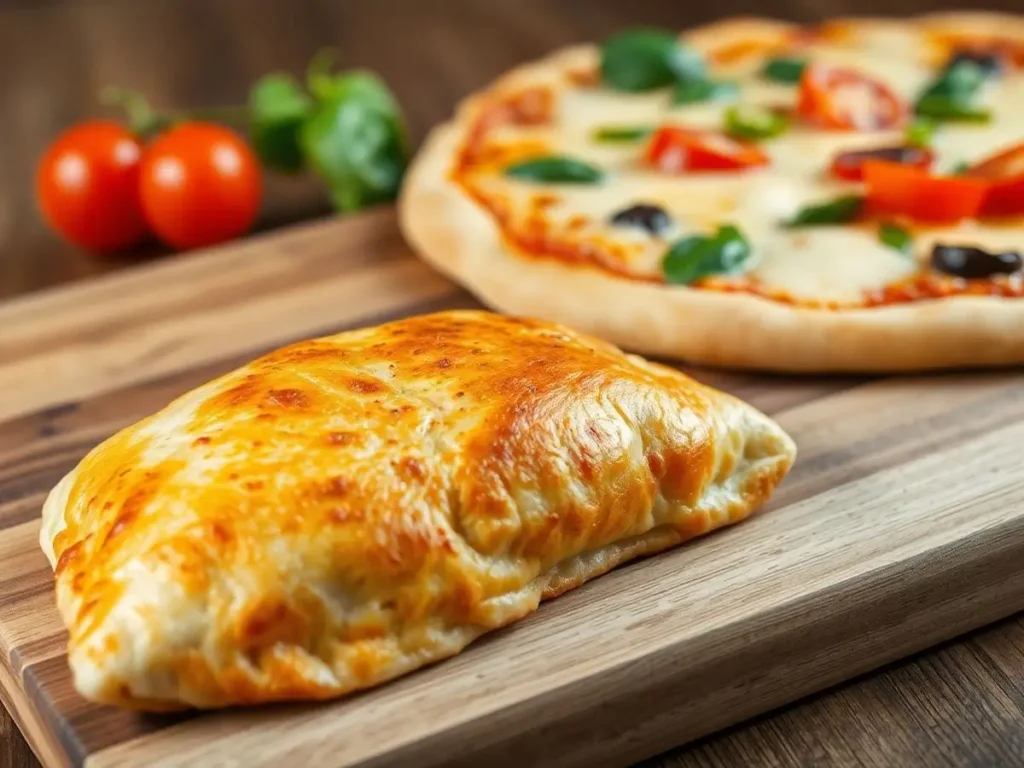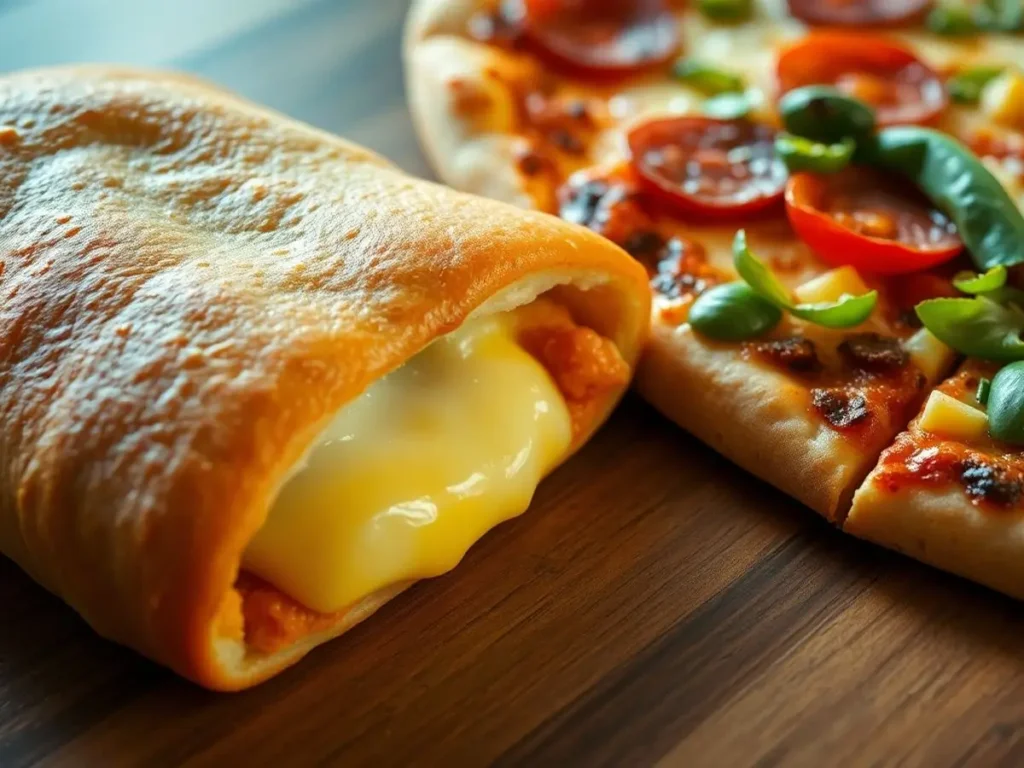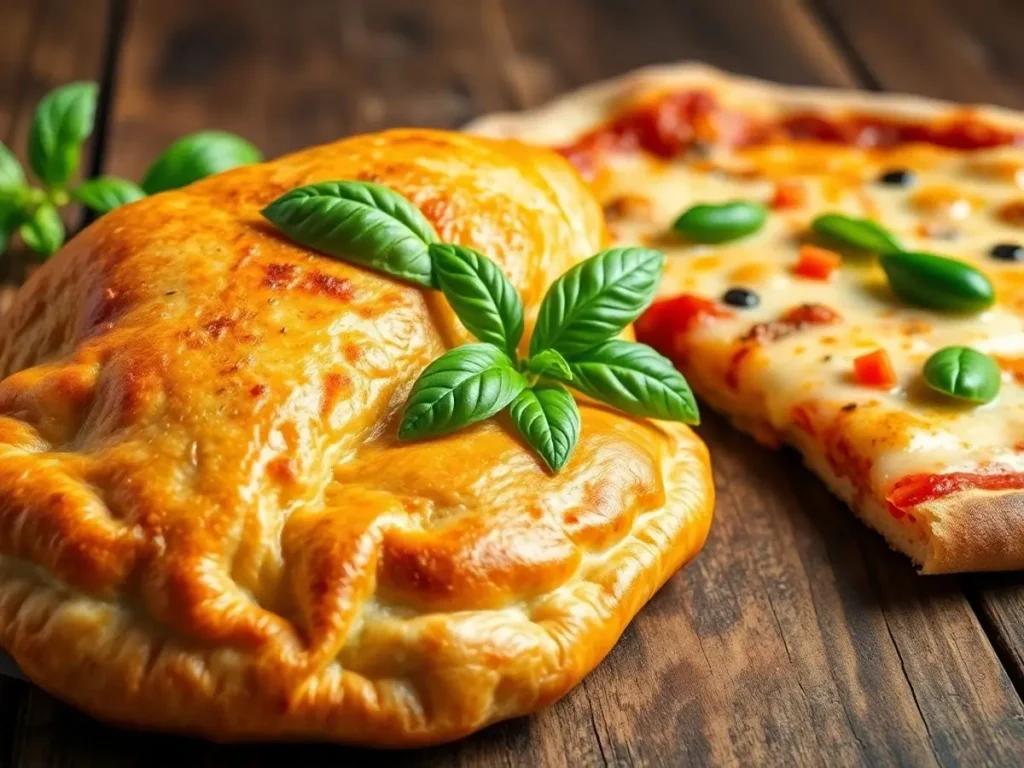Ever wondered if calzones are a healthier pick over pizza? It’s a debate that’s been simmering for a while. Both are delicious, both are doughy, and both can be packed with all sorts of tasty fillings. But when it comes to health, does one really edge out the other? Let’s break it down and see which one might be a better fit for your diet.
Table of contents
Key Takeaways
- Calzones and pizzas share many ingredients, but their preparation and portion sizes can lead to different nutritional outcomes.
- A typical calzone can pack more calories than a couple of slices of pizza due to its size and filling.
- Using whole wheat dough and loading up on veggies can make both calzones and pizzas healthier.
- Portion control is crucial; eating an entire calzone can exceed daily calorie recommendations.
- Stromboli offers another option, with differences in ingredients and preparation affecting its health profile.
Understanding the Nutritional Differences

Caloric Content of Calzones
When it comes to calories, calzones often bear the brunt of sugar and fat content due to their dense fillings. A typical calzone can pack over 1,000 calories, which is equivalent to about three slices of pizza. This is mainly because the fillings, often loaded with cheese slices, meats, and sometimes even brown sugar, are encased in a thick dough. The primary difference here is the compact nature of calzones, which concentrates the calories in a smaller volume.
Caloric Content of Pizza
On the flip side, pizza, often seen as a comfort food, tends to have a more balanced caloric distribution. A single slice of pizza usually contains around 300 calories. The slight differences in calorie content can be attributed to the spread-out nature of the toppings over a large surface area, allowing for more controlled portion sizes. This makes pizza a more flexible option for those watching their calorie intake.
Nutritional Value of Ingredients
The nutritional value of both calzones and pizzas largely depends on the ingredients used. Key differences include the types of cheese and meats, as well as the inclusion of vegetables. For instance, a veggie-loaded pizza might offer more fiber and vitamins compared to a meat-heavy calzone. Both dishes can be adjusted to include healthier alternatives like whole wheat dough or low-fat cheese, impacting the connection between foods and overall health. Understanding these nuances can help in managing blood sugar levels and making more informed dietary choices.
For tips on storing your leftovers properly, whether it’s calzones or sweet treats, check out How to Store Leftover Cranberry Lemon Bars.
In essence, while both calzones and pizzas can be customized to fit a healthier lifestyle, their nutritional profiles are shaped by the ingredients and portion sizes. Choosing wisely between these options can signal a positive shift in your eating habits.
Exploring Ingredient Variations
Common Ingredients in Calzones
Calzones, often made with basic bread dough, are a delightful twist on traditional pizza. The dough is folded over to encase a variety of fillings, which typically include a mix of ricotta and mozzarella, forming rich cheese blends. Meats like ham or pepperoni and vegetables such as spinach or mushrooms often find their way into calzones, making them a hearty meal.
Common Ingredients in Pizza
Pizza, the ultimate comfort food, is known for its flat base topped with tomato sauce, mozzarella, and a variety of toppings. These can range from pepperoni and sausage to vegetables like bell peppers and olives. The primary difference between pizza and calzones lies in their structure, with pizza being open-faced, allowing for a crispy texture.
Healthier Ingredient Alternatives
For those mindful of their health, there are ways to tweak both calzones and pizza to be more nutritious. Here are some tips:
- Opt for whole wheat dough instead of white flour to increase fiber content.
- Use part-skim or reduced-fat cheese to lower calorie and fat intake.
- Load up on vegetables like spinach, peppers, and onions for added nutrients.
Just as unique combinations make Crumbl Cookies stand out, experimenting with ingredients can elevate your calzone or pizza recipe. Learn more in What Makes Crumbl Cookies Unique?.
While both calzones and pizza share many ingredients, it’s the baking approach and choice of fillings or toppings that can significantly impact their nutritional value. Making small changes can help manage blood sugar levels and reduce the brunt of sugar intake, making these dishes healthier without sacrificing flavor.
Comparing Preparation Methods
Baking Techniques for Calzones
When it comes to baking calzones, the process is both an art and a science. Typically, calzones are baked on a baking sheet, which helps evenly distribute heat and achieve that perfect golden crust. The primary difference between a calzone and a pizza is that a calzone is folded, so the baking approach must ensure the inside ingredients are cooked thoroughly without burning the outer layer. Using a bread machine can simplify dough preparation, ensuring a consistent texture every time.
Baking Techniques for Pizza
Pizza, on the other hand, often requires a different baking technique. While some might use a baking sheet, others prefer a pizza stone for a crispier base. The baking process for pizza involves high temperatures to achieve a crispy crust while keeping the cheese slices melted just right. Unlike calzones, pizzas are open-faced, so the heat must be carefully managed to avoid overcooking the toppings.
Impact on Nutritional Value
The way you bake your calzone or pizza can significantly affect its nutritional value. Baking at high temperatures might lead to a loss of some nutrients, but it can also reduce the brunt of sugar in the dough, making it slightly healthier. Moreover, how you choose to bake can influence blood sugar levels, especially if you opt for whole-grain doughs or healthier toppings. The connection between foods and their preparation methods is crucial in determining their role as comfort food or brain food.
Evaluating Health Benefits
Potential Health Benefits of Calzones
Calzones, often seen as a comfort food, can be packed with nutrients if prepared wisely. Including vegetables like spinach or mushrooms can turn them into a powerhouse of vitamins and minerals. The choice of cheese also plays a significant role. Opting for part-skim mozzarella or ricotta can reduce fat intake. The primary difference between a healthy and an unhealthy calzone often lies in the choice of ingredients. For instance, using whole-grain dough can boost fiber intake, aiding digestion.
For those looking to recreate iconic recipes, don’t miss the Crumbl Cookie Recipe: Ultimate Guide.
Potential Health Benefits of Pizza
Pizza, another beloved comfort food, can be nutritious when made with the right ingredients. Topping it with a variety of colorful vegetables not only adds flavor but also essential nutrients. Opt for thin crusts to cut down on calories and consider using less cheese or choosing varieties with lower fat content. The baking process can also impact its nutritional value; using a baking sheet instead of a pan can help reduce oil use, making it a lighter option.
Nutritional Myths and Facts
There are common myths surrounding both calzones and pizza. One myth is that they are always unhealthy. However, with mindful ingredient choices, both can be part of a balanced diet. It’s crucial to understand the connection between foods and how they affect our bodies. For instance, opting for pizzas with whole grain crusts can help maintain stable blood sugar levels. Similarly, using brown sugar instead of white in dough recipes can lower the brunt of sugar impact on the body.
While both calzones and pizza can be indulgent, they don’t have to sabotage your diet. By focusing on ingredient quality and preparation methods, you can enjoy these dishes without guilt.
Stromboli vs Calzone: A Nutritional Perspective

Key Differences in Ingredients
Stromboli and calzones might seem similar with their pizza dough and cheese, but they have notable differences. The primary difference is in the assembly and ingredients. While both use mozzarella cheese, calzones often include Ricotta cheese as well, giving them a creamier texture. Stromboli, on the other hand, is more like a rolled stuffed bread and can feature a variety of meats and cheeses. Think of it as a savory roll-up, often shared among friends.
Caloric Comparison
When you’re watching your calories, both options can be heavy hitters. A large stromboli, packed with meats and cheeses, can quickly add up to over 3000 calories. In contrast, a typical cheese calzone might contain around 1700 to 2400 calories, depending on the filling. It’s important to note that the calorie count largely depends on the portion size and ingredients used.
| Dish | Calories (approximate) |
|---|---|
| Stromboli | 3110 |
| Calzone | 1700 – 2400 |
Healthier Choice Options
If you’re looking to make a healthier choice, consider these tips:
- Opt for whole wheat bread dough to increase fiber.
- Reduce the amount of mozzarella cheese and use part-skim varieties.
- Load up on vegetables instead of processed meats to cut down on saturated fats.
Choosing between stromboli and calzone doesn’t have to be a battle of indulgence. By tweaking ingredients and portion sizes, you can enjoy these comfort foods while keeping your health goals in check.
Making Healthier Choices Calzones Or Pizza

Tips for Healthier Calzones
Choosing healthier options for calzones can be a game-changer. Here’s how:
- Opt for whole-grain dough: It adds fiber and nutrients compared to regular dough.
- Load up on veggies: Fill your calzones with spinach, mushrooms, or bell peppers instead of just cheese slices.
- Go easy on the cheese: Use reduced-fat mozzarella or try a sprinkle of Parmesan for flavor without the extra fat.
Remember, calzones can be a comfort food, but with a few tweaks, they can be a nutritious choice too.
Tips for Healthier Pizza
Pizza doesn’t have to be a guilty pleasure. Here are some ways to make it better for you:
- Choose a thin crust: It reduces the calorie count and allows you to enjoy more toppings.
- Use a tomato-based sauce: It’s a basic food that adds flavor without the brunt of sugar found in some creamy sauces.
- Top with lean proteins: Chicken or turkey can add protein without raising blood sugar levels signal.
If you’re a fan of experimenting in the kitchen, you might enjoy trying recipes like Lemon Cheesecake Crescent Rolls: A Sweet Twist.
A well-made pizza can be both delicious and nourishing, striking a balance between taste and health.
Balancing Flavor and Nutrition
Balancing flavor and nutrition doesn’t mean sacrificing taste. Here’s how:
- Experiment with spices: Herbs like basil, oregano, and garlic powder can enhance flavors without the need for extra salt.
- Watch your portion sizes: Keep an eye on serving sizes to manage caloric intake effectively.
- Bake on a baking sheet: This baking approach can help crisp the crust without excess oil.
With slight differences in preparation and ingredients, both calzones and pizza can be transformed into brain food, supporting a healthy lifestyle while satisfying your cravings.
Understanding Portion Control
Serving Sizes for Calzones
When it comes to calzones, portion control is key. A typical calzone can be quite hefty, often containing the equivalent of multiple slices of pizza. Amounts of cheese packed into a calzone can significantly increase its caloric content. To manage this, consider sharing a calzone with a friend or saving half for later. This not only helps in reducing intake but also lets you enjoy the meal without overindulging.
Serving Sizes for Pizza
Pizza slices are a bit easier to manage in terms of portion control. However, the temptation to eat slice after slice is real. A good rule of thumb is to stick to two to three slices, depending on the size and toppings. Keep in mind that pizzas loaded with batches of cheese can quickly add up in calories. Opting for a side salad or some veggies can balance the meal.
Managing Caloric Intake
Balancing your intake of calzones and pizza involves being mindful of the ingredients and preparation methods. Both can be heavy on carbs and fats, especially with generous cheese portions. To keep your diet in check:
- Choose thin crust over thick crust to cut down on carbs.
- Limit the use of brown sugar in sauces to avoid unnecessary sugars.
- Be cautious of the brunt of sugar in certain toppings that might spike blood sugar levels.
Being aware of portion sizes can make a significant difference in your overall caloric intake. It’s not just about what you eat but how much you eat that impacts your health. Whether it’s a comfort food like pizza or a hearty calzone, understanding portion control helps maintain a balanced diet.
Conclusion
So, are calzones healthier than pizza? Well, it really depends on how you make them. Both start with similar ingredients, but the way you assemble them makes a big difference. Calzones often pack in more calories because of all that dough and cheese, but they also hold in flavors well and offer the option to stuff them with veggies for a healthier twist.
On the other hand, you can make pizza lighter with a thin crust and less cheese. Ultimately, it comes down to what you want from your meal. If you crave something filling and flavorful, a calzone might be your go-to. However, if you’re watching calories, a slice of pizza could be the better choice. Either way, enjoy what you eat, and consider trying a healthier homemade version!
Frequently Asked Questions
What is the main difference between a calzone and a pizza?
The main difference is in the shape and how they’re cooked. A pizza is flat and open-faced, while a calzone is folded over, creating a pocket-like shape.
Are calzones healthier than pizza?
It depends on the ingredients and serving size. Calzones can be higher in calories due to the extra dough, but using healthier ingredients can make both options better for you.
Can I use whole wheat dough for calzones and pizza?
Yes, using whole wheat dough can add more fiber and nutrients, making your calzone or pizza a healthier choice.
What are some healthy toppings for calzones and pizza?
Vegetables like spinach, mushrooms, and bell peppers are great toppings. You can also use lean proteins like chicken or turkey.
How can I reduce the calories in my calzone or pizza?
Use less cheese, choose low-fat options, and add more vegetables. Also, watch your portion sizes to help manage calorie intake.
Is it okay to eat a whole calzone by myself?
Calzones are usually meant to serve multiple people. Eating a whole one might mean consuming too many calories, so it’s better to share or save some for later.
